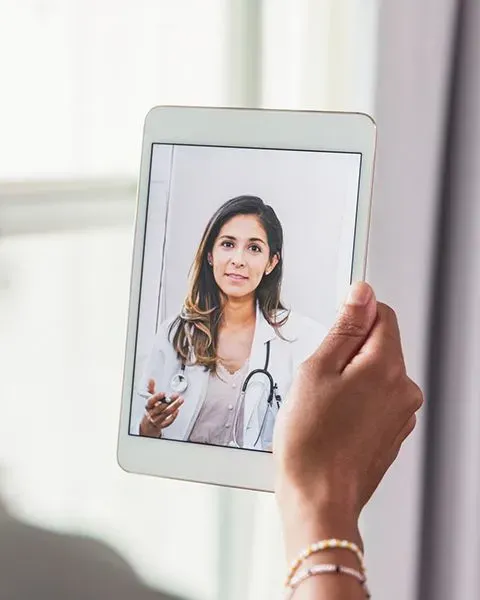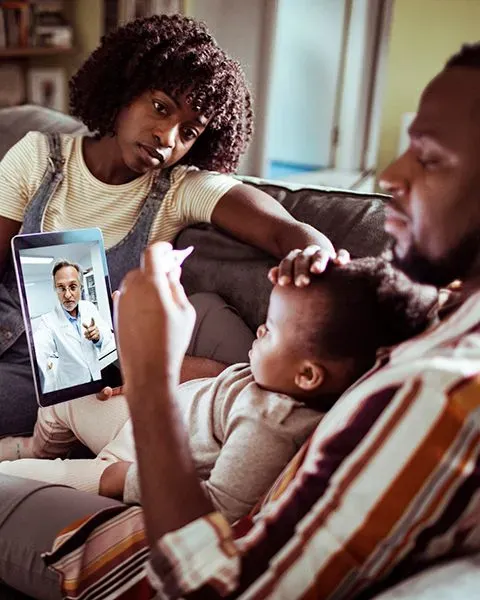
Dispelling Medical Mistruths
The internet is filled with medical facts and falsehoods. Learn how to turn your patients’ misinformation into a relationship-building opportunity.
February 4, 2021
Turn Misinformation Into an Opportunity
The internet can be a powerful health care tool — giving patients access to their medical records and enabling direct communication with their providers. But it can also be a source of misinformation. Physicians are in a unique position to help dispel medical mistruths and direct people to the most reliable information sources. And by doing it the right way, they can also enhance their relationships with their patients.
Facing the Facts About the Internet and Medical Misinformation
A 2021 Pew Research Center survey of internet use found that 85% of Americans are online daily, with 31% reporting they are online "almost constantly."
More and more, people are turning to the internet for answers to their health questions. In their last "Health Online" survey, Pew found that 72% of U.S. adults went online for health information. The same survey found that a third of American adults had gone online specifically to diagnose a medical condition.
If it’s on the internet, it must be true, right? Not so fast. The prevalence of misinformation and its online spread led Dictionary.com to choose misinformation as its 2018 word of the year.
Defined as “false information that is spread, regardless of whether there is intent to mislead,” misinformation is becoming an increasingly large problem for health care providers.
With so many people accessing the web, social media and other digital platforms for health information, it is likely that they are finding both facts and falsehoods.
Dr. Diana Huang, a family medicine physician with Swedish Capitol Hill Primary Care, says she regularly encounters medical misinformation among her patients. It often comes from internet searches or things they’ve read on social media. But, says Dr. Huang, as much as the prevalence of false information frustrates her, the fact that she hears it from her patients does not.
"I'm glad they are coming to me and sharing what they’ve found," Dr. Huang says. "Some people find misleading information online and use it to make important health decisions without consulting their physician. If they bring it to me before making a decision, this opens the door for a discussion."
The Different Levels and Sources of Medical Misinformation
While some medical misinformation has the potential to be rather harmful, other mistruths are simply not helpful. And many advertised "quick fixes" — like certain supplements or crash diet programs — are expensive for consumers. Medical misinformation can also be costly for the broader health system. For example, requests for unnecessary or excessive testing can result in misuse of medical resources.
A 2018 Pew study found that 81% of Americans rely on their own research — often using the internet — to make significant decisions.
For health-related decisions, internet resources may include:
Health-Focused Websites: Some online health sources include sections that allow consumers to post reviews of treatments, drugs and supplements. These are unregulated discussions, with first-hand accounts that aren’t applicable to all.
Online Advertising: Direct-to-consumer ads from pharmaceutical companies can be beneficial if consumers use them to have discussions with their doctors. But it’s important to remember that these companies are still trying to sell a product.
Social Media: According to a Pew study concluded last year, people who relied on social media for their news were less likely to get the facts right about major news stories and were more likely to be exposed to unproven claims.
Though all sources and levels of medical misinformation can be problematic, Dr. Huang says she worries most about a developed mistrust in doctors or modern medicine, which can prevent people from seeking care altogether. Without a physician-patient relationship, there isn’t an opportunity to address misinformation. That’s why, says Dr. Huang, it’s important to keep communication channels open and even encourage internet use if that means patients will use it to stay in touch with their provider and bring what they’ve found to their appointment.
5 Ways to Combat Medical Misinformation in Your Practice
If your patients come to you with medical misinformation, Dr. Huang says there are things you can do to communicate the truth and strengthen your physician-patient relationship.
1. Start With Thanks
Thank your patients for sharing the information they’ve found or for asking questions about a specific medical topic. Showing gratitude will encourage continued discussion
2. Gain Understanding
Ask your patient where their particular concern may be coming from. “Coming from a place of curiosity and a desire to understand can take any potential charge out of a discussion,” says Dr. Huang.
3. Show Empathy
Once you understand where a person is coming from, try to put yourself in their shoes. This is a great way to build trust and approach medical misinformation.
Dr. Huang says it’s important to remember that each patient has their own personal health care experiences, or they may operate based on the experiences of close friends or family. Both can impact their decisions and the sources they use to gather health information.
4. Find Middle Ground
Sometimes, misinformation is at play. Other times, patients and their doctors may have philosophical differences. Vaccinations, for example, can be a polarizing issue. Dr. Huang stresses that even when there are differing opinions on what’s best, it’s important to stay engaged with patients so you can work together to set and meet shared goals.
If your patient is adamant about something you see as misinformation or the wrong approach, Dr. Huang suggests focusing on understanding what they are thinking. Once you have more information, you could try using data to address their concerns.
"It is hard to change minds in one visit," says Dr. Huang. "And you may never change someone’s mind. But you can often find middle ground."
5. Share a Medical Information "Checklist"
Offer patients trustworthy resources and tips for their online medical research.
Start by sharing the following checklist:
- Search websites run by well-known health institutions or government (.gov), education (.edu) or professional agency (.org) sources.
- Always look for the names and information about content authors and reviewers to verify that they have health care credentials.
- Check content for dates to be sure it's current. Be wary of information that's more than 2 to 3 years old.
- Seek out more than one credible source to verify what you’ve found.
The National Library of Medicine offers additional tips for finding trustworthy sources.
Your Role Beyond Your Practice Walls
With more people using the internet to find medical information, the chances are high they will search for information about their doctors, too. It may not be enough to have a standard bio and contact information. Consider adding to your online presence to gain credibility.
"Patients look us up and they may want to know what their doctor thinks about specific topics," says Dr. Huang. "It takes a little extra commitment and may feel uncomfortable at first, but having a social media presence — even if it's minimal — can allow you to post about topics where misinformation tends to be widespread."
Dr. Huang says you can also use other platforms to correct medical misinformation. These include media interviews and online forums.
"Be sure you know your stuff so you can present yourself in the best way," says Dr. Huang. "Be honest about what you know and what you don't. And, most important, withhold judgment of those with differing ideas. Always be curious and kind in your approach."
Additional Articles

PS&D Partners
Providence: A Leader in COVID Care

Telehealth
Caring for Patients Through a Screen

Telehealth